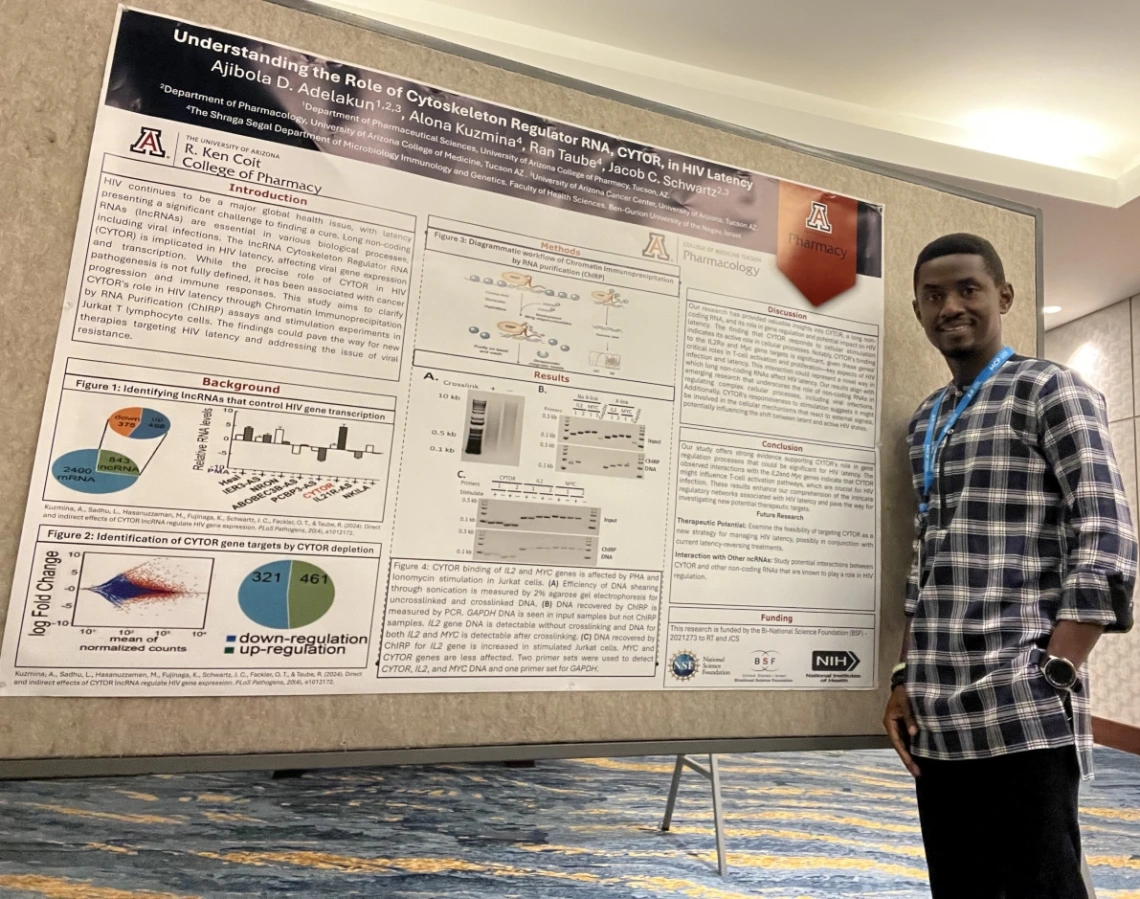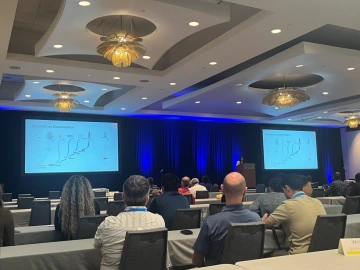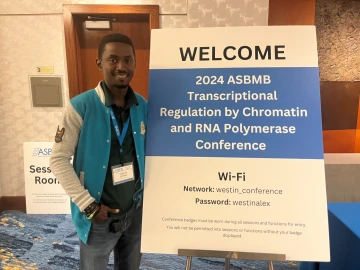PhD Student Spotlight: Ajibola D. Adelakun

Ajibola D. Adelakun received his Bachelor's Degree in Botany in 2010 and his Master's Degree in Pharmacognosy in 2014 from the University of Ibadan in Nigeria. He is currently a fourth-year PhD student with a research focus on cancer biology, specifically on Ewing sarcoma, under the mentorship of Dr. Jacob Schwartz.
Q & A
What has been your favorite part of the PhD program, and why?
- My favorite part of the PhD program has been the opportunity to do lots of cutting-edge research that can make a real difference to human health. The PhD program pushes me to learn and grow every day. Every experiment, literature review and conversation with colleagues helps me become a better scientist and thinker. Here, we have access to the latest equipment and techniques. Learning to use these tools and apply them to solve complex problems is fun and rewarding. It’s amazing to know that my research is contributing to the wider scientific community. Whether it’s developing new drug delivery systems, protein/nucleic acids-protein interactions, finding new targets or improving existing treatments, I feel like I’m part of something bigger than myself. The relationships I’ve built with my supervisors, fellow students and other researchers in the field have been incredible. I’ve had the opportunity to mentor students interested in this area. These connections support my current work and open up future opportunities. Perhaps most importantly, there’s the knowledge that my research could one day become a treatment that improves patients’ lives. That’s what gets me through the PhD program.
What year do you expect to graduate?
- 2026
What are your post-graduation plans?
- At this stage, the main aim is to find a postdoctoral position after graduation. I estimate that having a postdoc will assist me with the necessary experience and qualifications to progress within my academic profession. Later, I look forward to becoming more engrossed by the possibility of working in academia, and my goal in the long run is to turn to the universities where I wish to teach, conduct research and supervise students in the relevant field. I gladly accept the fact that this will not be an easy career to undertake and will demand great commitment and steadfastness. At the same time, it is those very challenges that make me forward-looking. Presently, I'm focusing on developing academic skills and motioning to effect practice within my area of specialization, although I am still uncommitted to other potential available possibilities within academia. I appreciate that it helps orient me toward the primary directions of my work and immediately take hold of the opportunities that align with my academic interests.
What’s the best piece of advice you’ve received from a professor or mentor?
- One of the most important aspects that doctoral students learned from their mentors relates to two pieces of advice. The first one involves seeking knowledge that excites the student because this will make for better research, professional paths, and in general, life. The second has to do with the need to be aggressive and active in interfacing with their teacher, fully understanding that the relationship will have profound consequences on their studies and future work. Indeed, my advisor never lets anyone forget that. He continuously stresses the need to impose upon all and any research problems, no matter how peripheral, an urgent question: What is the biological significance of this particular problem?
What was it about this area of research that inspired you?
- My primary research focus is in the field of cancer biology, specifically on Ewing sarcoma. This aligns with the core research interests of Dr. Jacob Schwartz's laboratory at the University of Arizona. Dr. Schwartz's work on Ewing sarcoma, the second most common pediatric bone cancer, involves investigating the proteins that drive this aggressive malignancy. Concurrently, I am involved in a collaborative, binational research project exploring HIV latency. This interdisciplinary endeavor is a joint initiative between my principal investigator and Dr. Ran Taube from Ben-Gurion University of the Negev, Israel. The HIV latency research has captivated my interest due to its profound implications for HIV treatment and potential cure strategies. HIV latency refers to the virus's ability to become dormant within host cells, effectively evading detection by the immune system and rendering antiretroviral drugs ineffective against these latent reservoirs. This phenomenon is a key factor in the persistence of HIV infection, even in patients undergoing antiretroviral therapy (ART). My scientific curiosity has been particularly piqued by the mechanisms of latency establishment, the genetic factors involved, and the regulatory networks governing HIV latency. Understanding how HIV transitions into a latent state within host cells, identifying the specific genes involved in establishing and maintaining latency, and elucidating the intricate regulatory networks are crucial areas of investigation in this field. This research not only contributes to the broader field of HIV/AIDS research but also offers potential insights that may be applicable to cancer biology, particularly in understanding cellular dormancy and reactivation mechanisms in the context of cancer stem cells or minimal residual disease.
Current Research
Recently, Adelakun attended the Transcriptional Regulation by Chromatin and RNA Polymerase Conference hosted by the American Society for Biochemistry and Molecular Biology in Alexandria, Virginia. According to the ASBMB website, "RNA polymerase II and its transcription machinery play an essential role in the modification and remodeling of chromatin; and chromatin regulates gene expression in both normal and pathological conditions. With recent innovations and technological advances in clinical and preclinical research, personalized medicine is becoming a reality, in part because of advances in our understanding of RNA polymerase II. Given this fact, many established and new investigators have taken on the challenge of elucidating the molecular mechanisms of gene expression by RNA polymerase II in the context of chromatin."
Presenting Understanding the Role of Cytoskeleton Regulator RNA, CYTOR, in HIV Latency, funded by the Bi-National Science Foundation (BSF) - 2021273 to RT and JCS, Adelakun shares more about his time at the conference and his current research.

What was the most unexpected thing you learned at the conference?
The conference proved to be very insightful. The world-renowned speakers present were of such high quality that it amazed me. This, and the sight of dozens of industry experts created an illusion in my head as to how vast and varied transcription is. It underscored just how serious and complex the subjects were. One expert said, "Transcription is complicated", a sentiment echoed by many other speakers. This way of thinking was a recurring narrative during the event. At the conference, it was explicitly proven that the alteration of chromatin structure can significantly influence RNA polymerase II activity at promoters. This challenges previous assumptions about how transcription regulation works, and it made me realize that my prior understanding of this process was perhaps oversimplified and incomplete. While this perspective adds nuance and depth to the field and my own understanding of it, it also explains why transcription is inherently capacious and complicated as ever.
Which speaker or session had the biggest impact on you and why?
All speakers made the most impression on me, but I would mention a few and say what I learned from them. Dr. Xueqin Sherine Sun spoke about the ways in which chromatin remodeling alters transcriptional circuitry in glioblastoma. She elaborated on the crosstalk between genetic and epigenetic alterations and how they work in alliance to redo the cancer-specific transcription circuitry. This discussion underscored the influence of genetic mutations and epigenetic alterations on the architecture of gene regulatory networks in cancer. It was also found out that such complex interactions may not only change the regulatory mechanisms of transcription, but also these may alter the transcriptional landscape of some malignant diseases suggesting potential new targets for therapies.
I also found out about a new technique GATO-seq during the talk given by Dr. Roberto Vazquez Nunez dealing with the dynamics of RNA Polymerase II promoter-proximal pausing. This inventive technique is developed to analyze this process at different levels of gene expression in time, primarily at the level of individual RNA molecules. The method aims at measuring changes in gene activity over time under different conditions employing advanced sequencing techniques. It was shown by Dr. Roberto that this method is capable of revealing both paused and arrested forms of the RNA Polymerase II enzyme.

Can you share more about your current research?
Our current research focuses on understanding the role of Cytoskeleton Regulator RNA (CYTOR) in HIV latency. We have identified CYTOR as a long non-coding RNA that acts as an activator of HIV gene expression and is upregulated following T cell stimulation. Long non-coding RNAs control gene expression and change how the DNA is packed. Recent research shows that the lncRNA Cytoskeleton Regulator RNA (CYTOR) is involved in HIV latency, which is the ability of the HIV virus to enter a dormant stage within host cells. We have recently found that CYTOR binds and stimulates the activity of P-TEFb, which increases phosphorylation of RNA Pol II and transcription. This research has been published in PLOS Pathogens in April 2024. This non-coding gene is also linked to cancer growth and immune system responses. However, the exact mechanisms through which CYTOR contributes to HIV pathogenesis remain unclear.
We employed a method called Chromatin Immunoprecipitation by RNA purification, (ChIRP) assay for CYTOR. We performed and optimized ChIRP of the CYTOR noncoding RNA in Human Embryonic Kidney (HEK293T) cells and determined CYTOR RNA present along the DNA of its own gene and the promoter of MYC. Using the T lymphocyte cell line, JURKAT, which is the cell line model for the study of HIV latency, we see that CYTOR binding to IL2Ra and MYC promoters are affected by stimulation with PMA (Phorbol myristate acetate) and Ionomycin. Our long-term goal is to combine ChIRP with next-generation sequencing (ChIRP-seq) to map CYTOR activity in T lymphocyte cells and its response to stimulation. Understanding how CYTOR is involved in HIV disease could help us develop new treatments that can penetrate resistance due to latency. The study provides new insights into the complex regulatory mechanisms of HIV latency and highlights the potential of targeting CYTOR as a novel approach for HIV latency reversal strategies.

